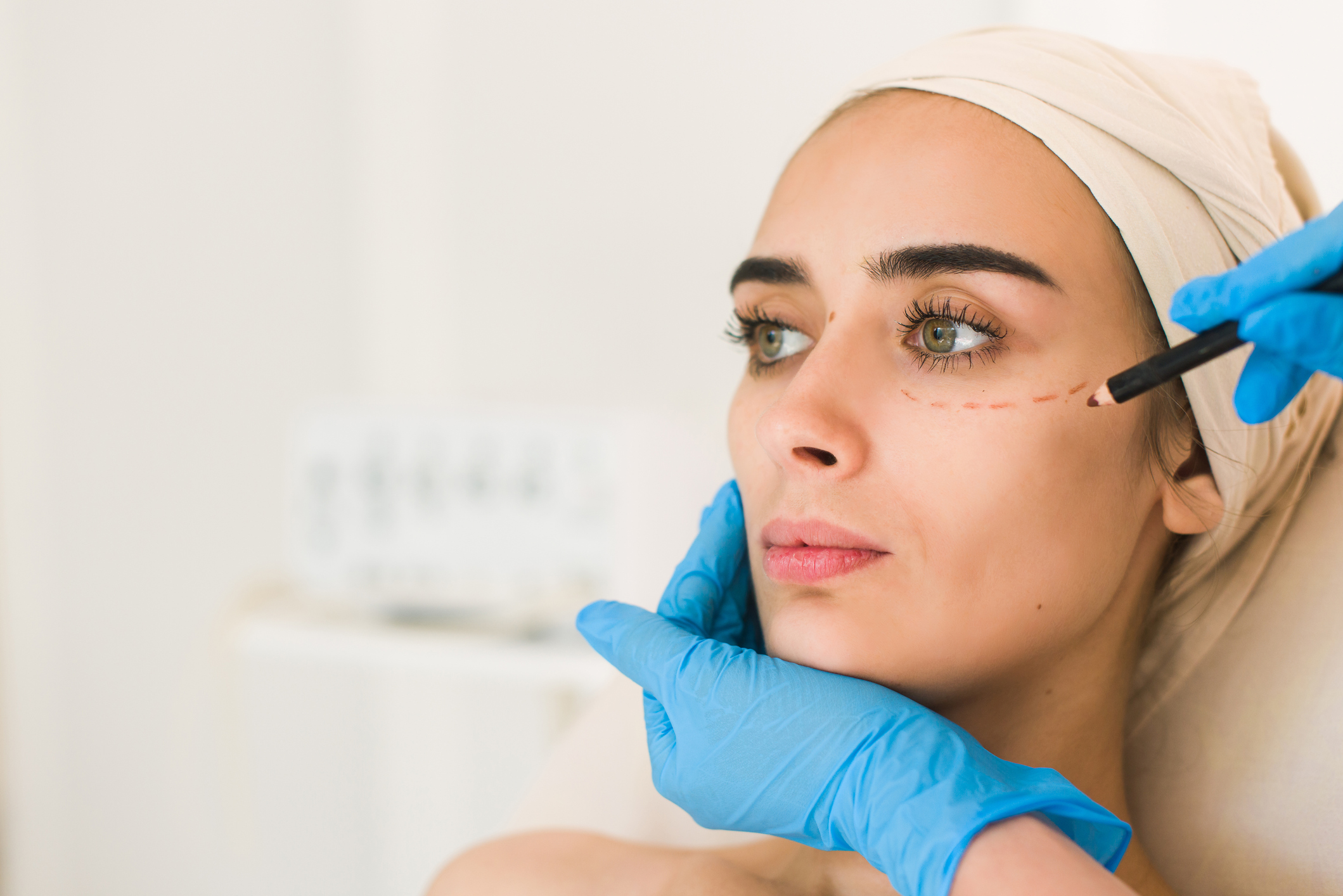Ptosis (Drooping of the Upper Eyelid)
‘Drooping’ of the eyelid can be present from birth or develop later in old age. It is a cosmetic problem, but if severe it can restrict vision too.
Causes
- By birth
- Myasthenia gravis
- Senile Ptosis: due to muscle weakness
Treatment
In most cases the treatment is surgery.
- LPS resection Surgery: This involves either strengthening the muscle, which elevates the lid, called LPS resection,
- Ptosis Sling Surgery: Lifting up the eyelid with the help of a graft. This graft can be taken from the patient’s thigh area or can be an artificial sling material. This procedure is known as ‘Frontalis Sling’.
Lid margin abnormalities
| Trichiasis | Entropion | Ectropion | |
|---|---|---|---|
| About | Trichiasis is a condition in which there is misdirection of eyelashes. | In a condition known as entropion there is inward turning of the eyelids, causing the eyelashes to scratch the cornea and produce irritation.
A patient may seek medical help because of tearing and secondary infection or for cosmetic reasons. It may involve the upper or lower lids. | Ectropion is the condition in which the lower lid turns away from the eyeball.
It is not only cosmetically unpleasant, it is also accompanied by bothersome tearing and infection. |
| Symptoms | In case the eyelashes turn inwards towards the eyeball, they may scratch the eye leading to poor vision.
May also lead to eye infection | ||
| Causes | Infections (trachoma)
Burns lid injuries | Muscle spasm
secondary contracture strictures from burns, injury or eye infection. | Eyelid laxity of the tissue in elderly people
Nerve paralysis of the seventh cranial nerve (the nerve which controls facial expressions) It may also follow cuts, infections, or burns of the lids and face that heal poorly; the resultant scar tissue forms adhesions that cause the lids to turn out. |
| Treatment | Removal of the misdirected eyelashes or corrective plastic surgery on the lid relieves symptoms. | An adhesive tape applied to the skin of the lid temporarily may straighten the lid and relieve the uncomfortable symptoms. Corrective surgery is usually required for a permanent cure. | Surgery is the only available treatment option. Surgical rotation of the lid margin and its alignment with the eyeball. |
Lacrimal Passage Diseases
Tears from the eye drain to the nose through the lacrimal passage. If there is a blockage in this passage, watering results. The causes can be incomplete development, as seen in young children, or infection, which happens in adult life.
Symptoms
- Watering
- Recurrent Infections
Treatment
It includes:
- Probing: It involves ‘probing’ the pathway with a thin metallic guidewire to open it
- DCR: A more complex surgery which involves creating an alternative pathway to drain the tears to the nasal cavity. This procedure is known as dacryocystorhinostomy (DCR). usually done Endoscopically (Scar-free) or an external approach (Rarely used)
Lid Injury
A lid injury may result in not only making the eye look cosmetically unpleasant, any irregularity of the lid margin is also functionally damaging to the eye, as a lid with a defect may fail to cover the cornea fully and provide adequate lubrication. An oculoplastic surgeon repairs the injury in a way to make the lid as close to normal as possible.
Lid Tumour
A suspicious lid mass needs to be removed and examined, after which the lid defect needs to be reconstructed. Histopathological examination under a microscope using the help of a pathologist determines whether the lesion is cancerous or not, and the chances of its recurrence. Reconstruction in the form of suturing, tissue flaps from neighboring areas and other lid, and grafts preserve the lid function.
Eye cancer
Cancer can also occur in and around the eye. Cancer happens when healthy cells in the eyes mutate in a disorganized way which leads to the growth of a tumour.
Symptoms
- Bulging eyes
- Blurred vision
- Flashes of light (floaters)
- A new dark spot in the eyes
- Loss of peripheral vision
- Change in the colour of the iris
- Pain and redness in the eye
- White reflex in the eye
Causes
A variety of reasons ranging from heredity to excessive interactions with UV radiations are the possible causes.
Treatment
Eye cancer treatment can be done in four ways.Your eye specialist will decide on which treatment to pursue depending on the type of cancer, size and vastness of cancer, the health, age, and fitness level of the patient, etc.
- Radiotherapy
- Radiation is a treatment option that aims to kill cancer cells using radioactive elements and doesn’t give the patient too much discomfort.
- Chemotherapy
- Chemotherapy involves injecting certain drugs into the body of the patient. The drug can be given either by mouth in the form of a tablet or injected. This treatment is done if the eye cancer becomes severe.
- Laser Therapy
- Laser therapy uses heat in the form of a laser to shrink the tumour in a procedure called transpupillary thermotherapy (TTT). This treatment has fewer side-effects as compared to radiation therapy or eye cancer surgery.
- Surgery
- Sometimes other methods are not enough, therefore, surgery is the only option left. During the surgery surgeons remove the affected eye altogether or parts of it depending upon the severity of the case.
Ocular, Orbital and Facial Prosthesis
We offer state-of-the-art services for cosmetic procedures of the eyes and face. Our eye surgeons who are experts in cosmetic eye surgery strive to rehabilitate patients impacted by eye cancer cosmetically through ocularistry.
Our ocularistry service comprise of the following:
- Custom ocular prosthesis
- Lightweight prosthesis
- Silicone prosthesis
- Custom conformer
- Self-lubricating prosthesis
- Hydrogel socket expansion
- Glue-on and spectacle-mounted exenteration prosthesis
- Facial prosthesis and osseointegrated prosthesis in collaborations with a maxillofacial surgeon
Socket surgery
An eye that has lost complete vision and is painful needs removal. The deep ‘socket’ left behind is not ideal for artificial eye fitting. Therefore, at the time of eye removal, an implant is placed in the orbit. This reduces the hollowness of the socket seen with the artificial eyes placed without an implant.
In some people, the artificial eye fit changes with passage of time. Socket surgery aims at giving the best possible ‘bed’ for artificial eye fitting, with or without an orbital implant.
The above-mentioned list of disorders is not exhaustive. Do contact your eye specialist for more information.
FAQs
Why is oculoplasty done?
Oculoplasty is performed to improve the comfort, function, and appearance for the following:
- Eyelid malposition
- Tear drainage problems
- Problems of the orbit
- Cancers of the eyelid or orbit
What are orbital diseases?
Orbital diseases involve the tissues lying in the bony socket. Often the eyeball protrudes from its socket, producing a widening of the eyelids. Sometimes the frequency of blinking reduces and the patient develops a staring gaze. This may be due to an endocrine disorder (thyroid disease), inflammation of the orbit or a tumor. Normally these lesions require investigations including CT scan and MRI. Treatment varies from case to case, and may involve medical treatment, surgery, radiotherapy, chemotherapy or a combination of these.
What is eyelid cancer?
An eyelid cancer occurs on or inside your eyelid. Sebacous Gland carcinoma is the most common type of eyelid cancer in India.
What are the side-effects of chemotherapy in eye cancer treatment?
The side effects may include:
- Mouth sores
- Hair Loss
- Vomiting
Is eye cancer preventable?
Eye cancers are not preventable, but when detected and diagnosed at the right time, a good outcome can be achieved.
What are the different types of eye tumours that pose mixed effects on different age groups?
There are various types of tumours (benign or malignant) which pose mixed effects on different age groups:
- Uveal Metastasis: It is secondary cancer that spreads into the uvea of the eyes from some other affected part of the body.
- Melanoma: Melanoma or uveal melanoma is cancer, which develops due to the obstinate growth of a specific type of cell called melanocytes.
- Lymphoma: Tumor that develops from lymphoid cells within the eye or structure around the eye.
- Hemangioma: It is also a benign tumor. It emerges in the blood vessels and affects the retina and choroid.
How does an eye cancer specialist treat retinoblastoma?
Retinoblastoma is a rare type of eye cancer that usually develops in early childhood, typically before the age of 5. Eye cancer specialists treat retinoblastoma by chemotherapy, laser, and brachytherapy (an advanced form of local radiotherapy). This focuses on saving the child’s life, salvaging the eye, and protecting the vision. Treatment ensures 95% of the children are saved from death, over 90% have their eyes intact, and over 85% have their vision protected. In advanced cases, to save the child’s life and prevent cancer from spreading to other parts of the body, the eye may have to be removed.

